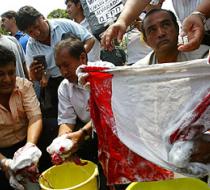Washing the Flag 1 Favorite
“It might not seem that an act of public laundry could unsettle a president with a well-deserved reputation for inflexibility, corruption, and brutality. But mass washing ceremonies were a key element in getting rid of Peru’s unpopular president, Alberto Fujimori, after more than a decade in power.
In May 2000, thousands started gathering every Friday, from noon until three, on Plaza Mayor in the Peruvian capital, Lima. The main focus: washing the red-white-red-striped flag. The crowds wanted to show that Peru, and its flag, had become badly soiled. The authorities reacted with intimidation and threats. Vladimiro Lenin Montesinos, head of the “security services, complained about this “cancer,” and suggested that the flag washers were terrorists. But still the lava la bandera —wash-the-flag—protests continued. As actor and protester Miguel Iza declared: “I just want a clean country.”
The protests spread across the country. Hundreds of thousands took part. Eventually, the lava la bandera action achieved its aim. Five months after the protests began, Fujimori stepped down. (He resigned by fax while on a visit to Japan.) Washing the flag, said the Peruvian daily La República in its end-of-millennium roundup, was “a ritual that we Peruvians will never forget.”
In 2009, Fujimori (extradited from Chile two years earlier) was jailed for twenty-five years for the killings committed under his rule. Peruvian flags are now clean.
Excerpt From: John Jackson and Steve Crawshaw, Small Acts of Resistance: How Courage, Tenacity, and Ingenuity Can Change the World.







